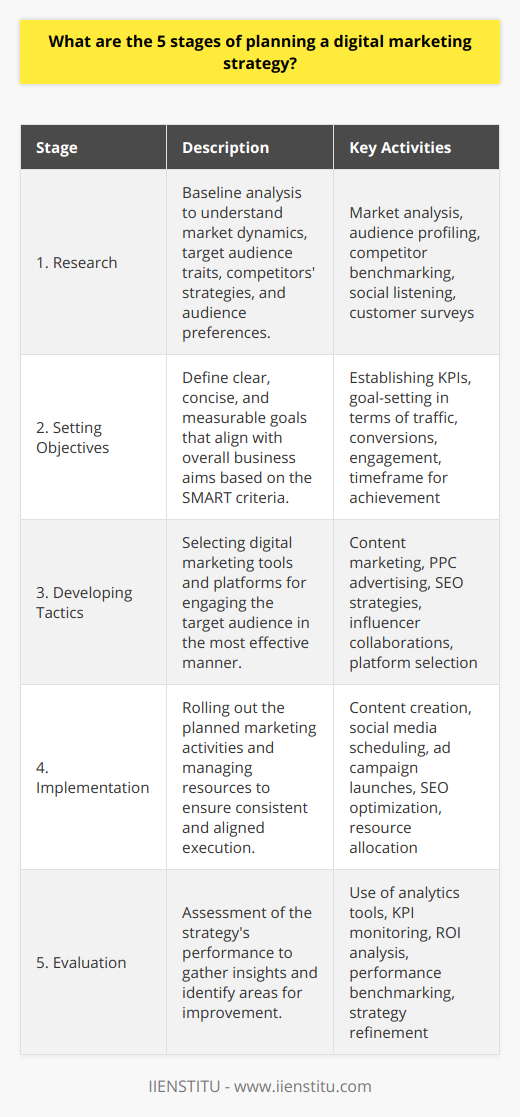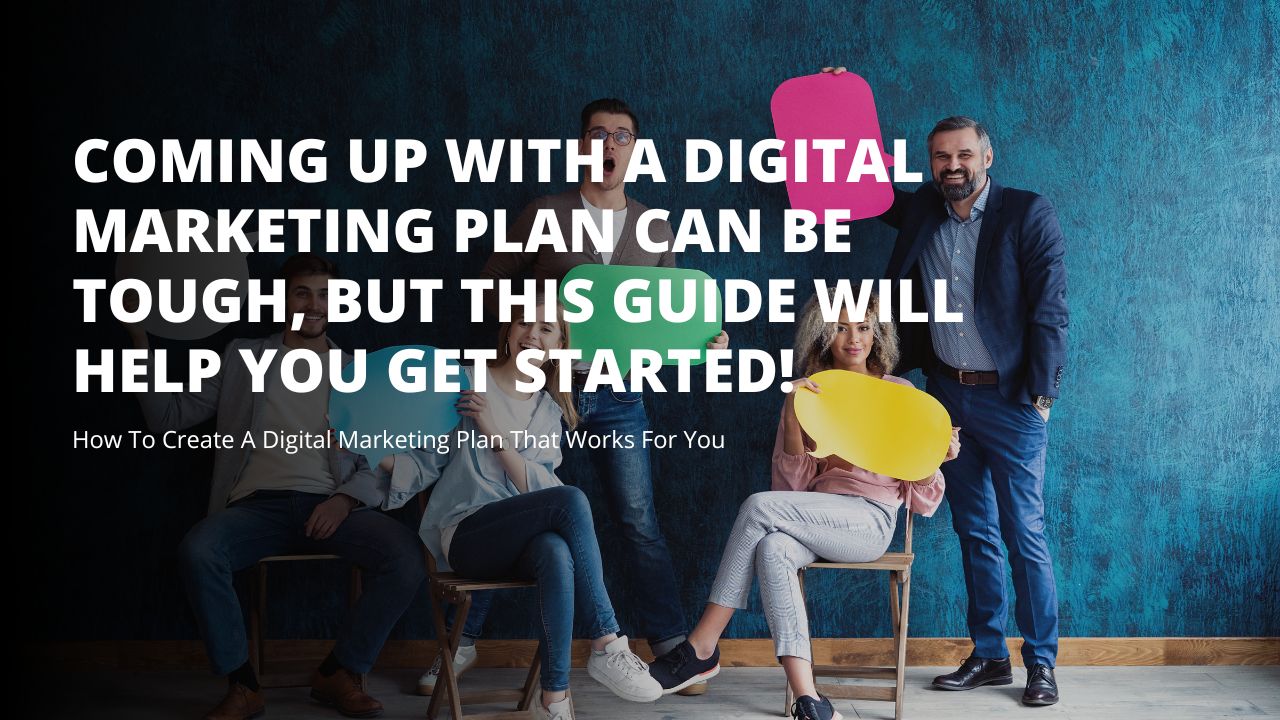
Do you wish you could find a digital marketing plan that worked for your business? Are you unsure where to start or what to include in your project? In this blog post, we will walk you through creating a digital marketing plan that works for you and your business. In addition, we'll provide tips on getting started and what to include in your project. So, let's get started!
This guide will help you create a perfect plan for your business.
When starting a new business, it's essential to create a solid plan that covers all the critical aspects of your venture. This guide will help you create a well-rounded business plan customized to meet your unique needs. But, first, let's look at some of the critical elements that every successful plan should include.
First, you should consider what you hope to achieve with your business. This can include increasing revenue, expanding your customer base, or diversifying your product line. Next, think about what resources you currently have available and what realistic goals for your current situation. You should also thoroughly research the market and competition and identify any weaknesses or gaps that could be exploited.
Another critical aspect of any business plan is how you will allocate resources to achieve your stated goals. Decisions on hiring, pricing strategies, advertising tactics, and supply chain management will play an important role here. And finally, don't forget to take into account any long-term plans or contingencies that may arise over time and how you will react if changes in the external environment inevitably occur. With careful planning and attention to these different elements, you can create a plan that helps spur your business forward and reach its full potential.
1. Define your business goals and target audience.
Before starting your product or service business, you need to define your business goals. What are you trying to achieve? For example, do you want to make a profit? Build a team of employees? Or serve a particular community? Once you know your goals, you can identify your target audience. Who are the people most likely to use your product or service? How can you reach them? Answering these questions will help you create a marketing plan that will get your business to a successful start.
2. Research your competition.
Any business owner knows that competition is fierce in the marketplace. To be successful, it's essential to research your competition and develop a marketing strategy that will set you apart from the rest.
Start by taking a look at other businesses in your industry. What are their strengths and weaknesses? What marketing tactics are they using? How effective are those strategies? This information will give you a good starting point for developing your marketing strategy.
Keep in mind that your competition is constantly changing and evolving, so staying up-to-date on their latest activities is essential. Regular basis. This way, you can adjust your marketing strategy to stay ahead of the curve.
By taking the time to research your competition, you'll be better positioned to develop a winning marketing strategy for your business.
3. Create a content calendar.
Creating a content calendar is an essential step in any content marketing strategy. By planning out what types of content you post and when you will post it, you can ensure that your content is timely and relevant to your target audience. A content calendar also helps you stay organized, making it easier to track your progress and measure your results.
There are a few things to keep in mind when creating a content calendar:
Consider which platforms you will use to reach your target audience. Social media, blogs, and email newsletters are all great options.
Decide what types of content you will post on each platform. Images, videos, and infographics are all great options for engaging content.
Determine how often you will post new content.
Daily or weekly postings are typically sufficient.
By following these tips, you can create a content calendar to help you reach your target audience and achieve your content marketing goals.
4. Determine your budget.
If you're looking to take your marketing efforts to the next level, a well-crafted budget is essential. Determining your budget requires consideration of both short-term and long-term costs. On the one hand, you need to think about expenses like printing materials and website development that contribute immediately to your marketing efforts. However, at the same time, it's essential to consider long-term investments like staff training and content creation that can take months or even years to show results. Accepting these considerations into account ensures that you have the resources necessary to achieve the results you want from your marketing activities. So whether you're working with a small budget or are looking for ways to maximize existing assets, be sure to put careful thought into your budget planning process. There's no limit to what you can achieve with the right approach and a little creativity!
5. Choose the right social media platforms for your business.
Before you choose a platform, it's essential to understand your goals. What do you want to achieve by being active on social media? Once you know your goals, you can narrow down your choices. For example, if you're primarily interested in driving traffic to your website, Facebook and Twitter may be better than Snapchat or Instagram. If you're looking to build brand awareness or generate leads, on the other hand, Snapchat and Instagram may be more effective. Ultimately, there is no "right" answer - it all depends on your specific goals and target audience. However, by choosing the right platform or platforms for your business, you can ensure that your social media efforts are more likely to be successful.
6. Engage with your audience.
Once you've established a presence on social media, it's essential to engage with your audience. Responding to comments and questions shows that you value your customers' input, while sharing relevant blog posts or articles helps keep them informed about your latest news. Running giveaways or contests is also a great way to build excitement and loyalty around your brand. You'll develop strong relationships with potential customers and create a loyal following by engaging with your audience.
7. Evaluate and adjust your plan as needed.
To be successful in today's competitive landscape, it is essential to have a well-planned and strategic digital marketing plan. This involves evaluating your current marketing efforts regularly, assessing any necessary changes or adjustments, and ensuring that you are always working towards achieving your business goals. By remaining flexible and proactive, you can create an effective digital marketing plan that will help your company reach new heights of success. So whether you are just starting or are an established business looking to reevaluate your strategy, be sure to take the time to evaluate and adjust your plan as needed. With the proper planning and discipline, you can create a digital marketing strategy that will serve you well for many years.
As you can see, a lot goes into a successful digital marketing campaign. It's essential to take the time to define your business goals and target audience, research your competition, create a content calendar, determine your budget, and choose the right social media platforms for your business. But don't worry – these are all things that can be learned. If you're looking for a comprehensive guide to digital marketing, we have just what you need. Our online Digital Marketing Course will teach you everything you need to know about setting up and executing a successful digital marketing campaign. So enroll now and start learning today!
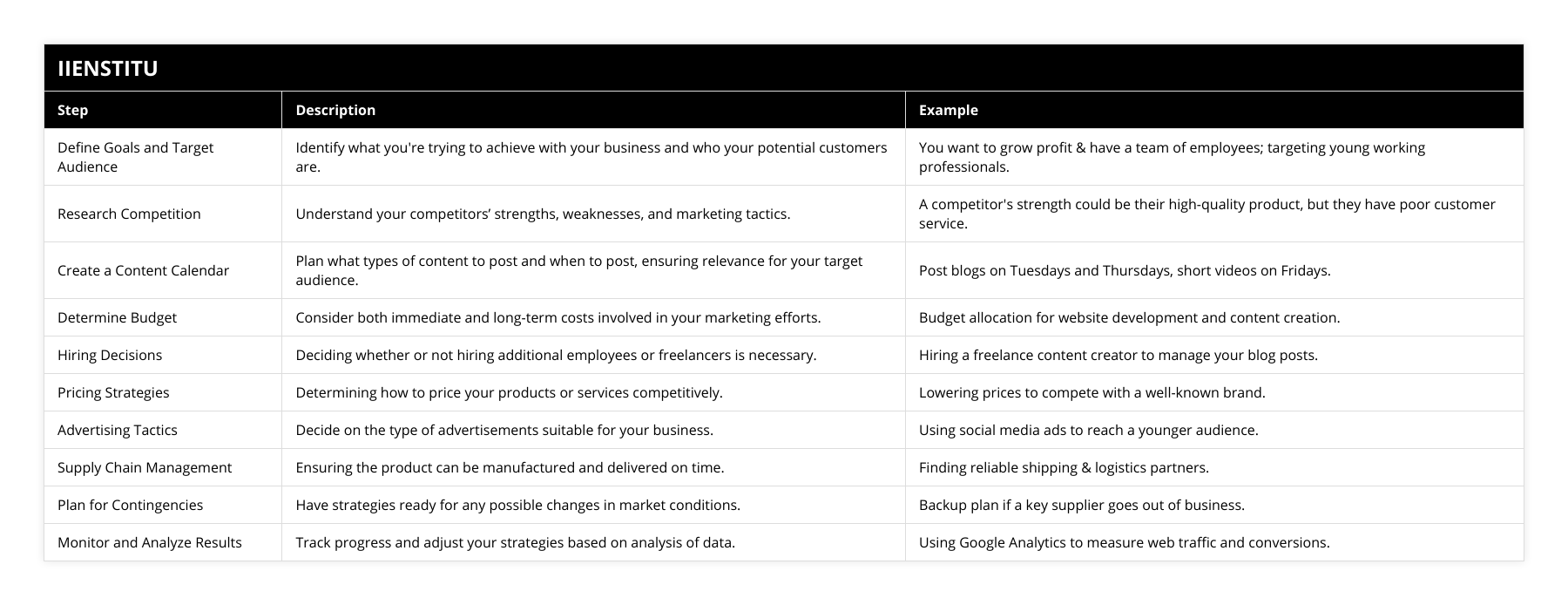
Frequently Asked Questions
What are the first steps to creating a digital marketing plan?
The first step is to define your goals and objectives. What are you trying to achieve with your marketing campaign? Next, you'll need to research your audience and figure out who you're trying to reach. After that, it's time to create a strategy and develop a plan of action. Last but not least, you'll need to track your results and measure the success of your campaign.
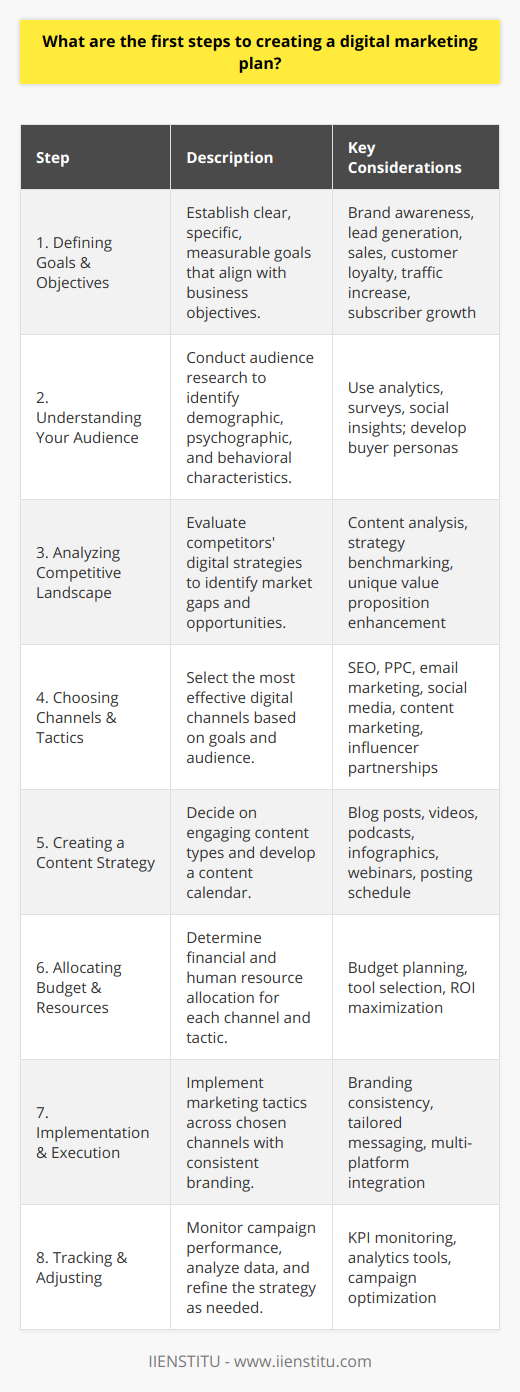
What should you consider when creating a content strategy?
Answer: When creating a content strategy you should consider the following:
1. Who is your target audience?
2. What type of content will you produce?
3. How often will you produce content?
4. Where will you publish your content?
5. What are your goals for your content marketing efforts?
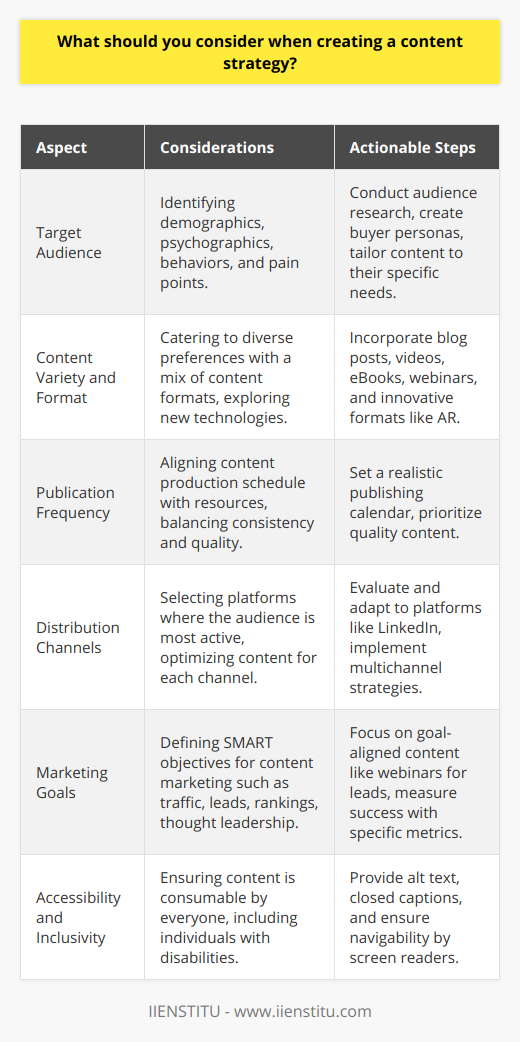
How do you measure the success of your digital marketing efforts?
There is no one-size-fits-all answer to this question, as the success of digital marketing efforts can be measured in many different ways, depending on the specific objectives and goals of the campaign. However, some common metrics that are often used to measure the success of digital marketing campaigns include website traffic, conversion rates, lead generation, and social media engagement.
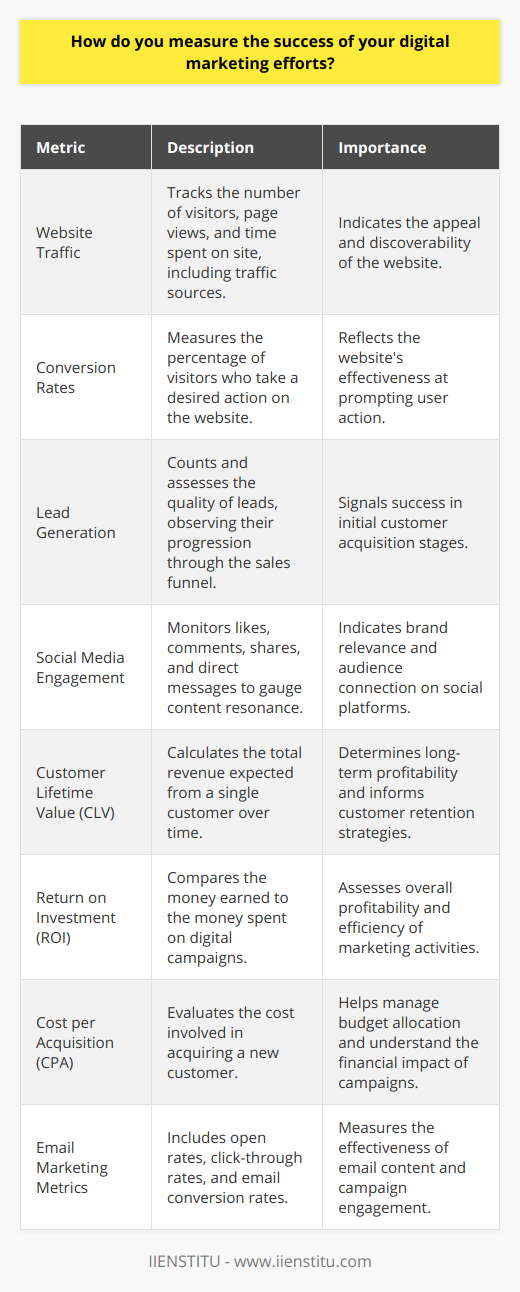
How do you create an effective digital marketing plan?
Understanding the Target Audience
To create an effective digital marketing plan, it is crucial to begin by understanding the target audience. Conducting market research helps determine customer demographics, behaviors, preferences, and motivations, which are essential for crafting tailored marketing strategies. This research can be conducted through surveys, interviews, or by analyzing data on customer interactions with previous marketing campaigns.
Defining Marketing Goals
Once the target audience is identified, it is essential to define clear marketing goals based on the organization's objectives. These goals should be specific, measurable, attainable, relevant, and time-bound (SMART). Defining marketing goals ensures that the digital marketing plan is focused and goal-oriented, making it more likely to achieve the desired results.
Choosing the Right Platforms
The next step is to select the appropriate platforms for reaching the target audience, based on their online behavior and preferences. Popular platforms include search engines, social media, email, and content marketing. Each platform should be selected purposefully, and should align with the marketing goals and target audience's preferences.
Creating Quality Content
A significant aspect of an effective digital marketing plan is creating high-quality content that engages and informs the target audience. This content must be relevant, interesting, and appropriately tailored to the target audience's preferences in terms of format, tone, and style. The content should also be optimized for search engines, ensuring it ranks highly in search results and reaches a broader audience.
Implementing Analytics and Tracking
Monitoring the success of a digital marketing plan is essential for identifying areas of improvement and measuring the return on investment (ROI). This can be executed by implementing analytics tools and tracking performance metrics, such as click-through rates, conversions, engagement rates, and more. Regularly reviewing and analyzing these metrics provides valuable insights for optimizing the digital marketing plan on an ongoing basis.
Optimizing and Adapting
A crucial factor in achieving success in digital marketing is the ability to optimize and adapt the marketing plan as needed. This involves regularly reviewing the plan's performance, identifying areas of weakness or stagnation, and making adjustments based on the insights gathered from analytics and data. Marketing strategies that work today might not be as effective tomorrow, so continuous adaptation and optimization are necessary for ensuring an effective digital marketing plan.
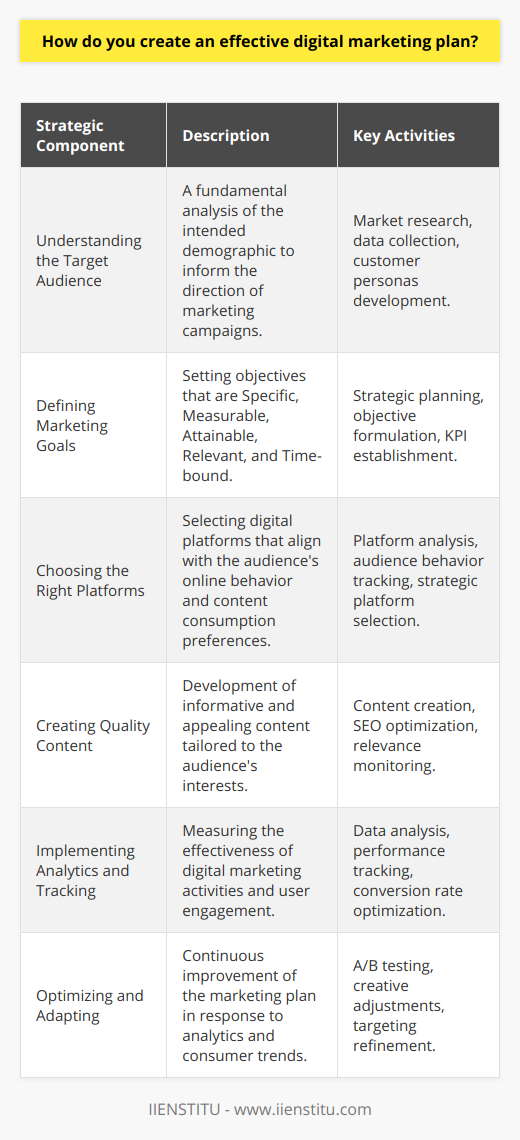
What are the 4 elements for a successful digital marketing plan?
**Defining the Elements**
A successful digital marketing plan must incorporate four key elements: a clear set of objectives, a comprehensive understanding of the target audience, the establishment of a content strategy, and a systematic approach to marketing analytics. By adhering to these elements, marketers can effectively leverage digital platforms to achieve their marketing goals.
**Setting Objectives**
Firstly, a digital marketing plan necessitates well-defined objectives that clarify the desired outcomes of the marketing efforts. These objectives generally align with larger business goals and should adhere to the SMART framework, making them Specific, Measurable, Achievable, Relevant and Time-bound. Establishing clear objectives facilitates the development of focused strategies and tactics to attain these goals.
**Understanding the Target Audience**
Secondly, comprehending the needs, preferences, and behaviors of the target audience is essential for crafting relevant and appealing marketing messages. By conducting thorough market research and utilizing customer data, marketers can develop detailed buyer personas. These personas enable the customization of marketing content and channels to resonate with the specific interests and requirements of the target audience.
**Establishing a Content Strategy**
Thirdly, devising a robust content strategy is vital for the effective execution of a digital marketing plan. The content strategy involves a careful selection of the types of content to produce, such as blog posts, social media updates, and videos, as well as the optimal distribution channels and frequencies for these materials. A well-rounded content strategy not only enhances brand awareness and credibility but also fosters strong relationships with the target audience, encouraging them to engage with the brand and ultimately make purchases.
**Analyzing Marketing Metrics**
Finally, a successful digital marketing plan necessitates the regular monitoring and evaluation of marketing metrics that align with the established objectives. By employing marketing analytics tools, marketers can measure the performance of their campaigns and strategies, and gain valuable insights into consumer behavior. This information allows for continuous optimization and refinement of the marketing plan, ultimately ensuring a positive return on investment.
In conclusion, a successful digital marketing plan is built upon the establishment of clear objectives, a comprehensive understanding of the target audience, the development of an effective content strategy, and the utilization of marketing analytics. By incorporating these essential elements, businesses can strategically engage with their audience through digital channels, effectively achieving their desired marketing outcomes.
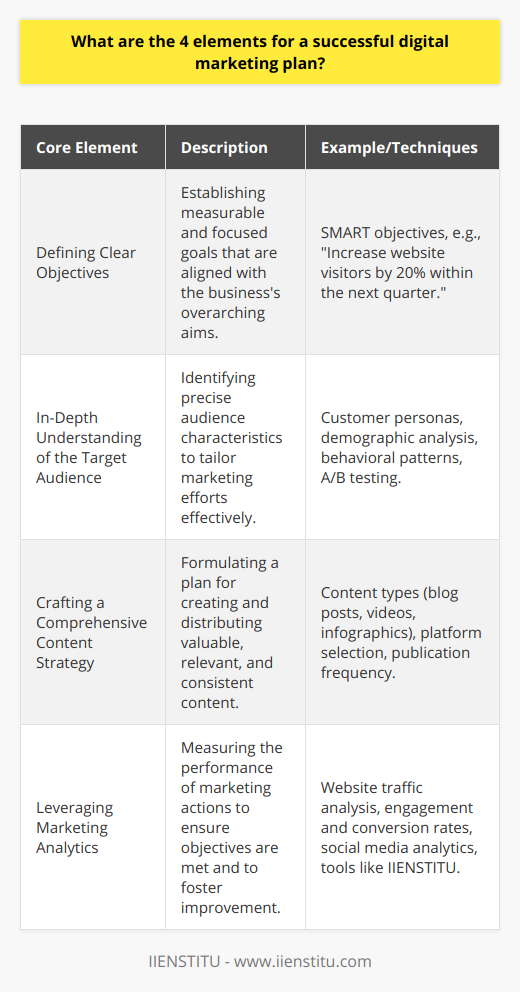
What are the 5 stages of planning a digital marketing strategy?
**Understanding the Digital Marketing Strategy**
Planning a digital marketing strategy involves five essential stages that ensure businesses effectively reach their target audience and achieve their goals. These stages include research, setting objectives, developing tactics, implementation, and evaluation.
**1. Research**
The initial step in planning a digital marketing strategy is conducting comprehensive research that involves identifying the target audience, understanding their needs and preferences, and analyzing market trends and competition. This process provides valuable insights to inform decision-making and create an effective marketing plan.
**2. Setting Objectives**
After completing the research, businesses should establish specific, measurable, achievable, relevant, and time-bound (SMART) objectives that align with their overall goals. These objectives serve as the foundation for developing a digital marketing plan and guide businesses in making strategic decisions.
**3. Developing Tactics**
With clear objectives in place, organizations must develop a tactical plan that includes the selection of appropriate digital marketing channels, such as social media, email marketing, content marketing, and search engine optimization. Businesses should consider their target audience's online behavior and preferences when selecting the most suitable channels.
**4. Implementation**
The next stage in the process involves implementing the devised digital marketing strategy. This includes creating and distributing engaging content across chosen marketing channels, allocating resources, and monitoring campaigns in real-time to ensure they reach the target audience and achieve the set objectives.
**5. Evaluation**
Lastly, assessing the effectiveness of the digital marketing strategy is crucial in determining its success. This involves analyzing performance metrics, such as engagement rates, conversion rates, and return on investment (ROI), and making necessary adjustments to optimize campaign performance. Through continuous evaluation, businesses can refine their digital marketing strategies to achieve better results over time.
